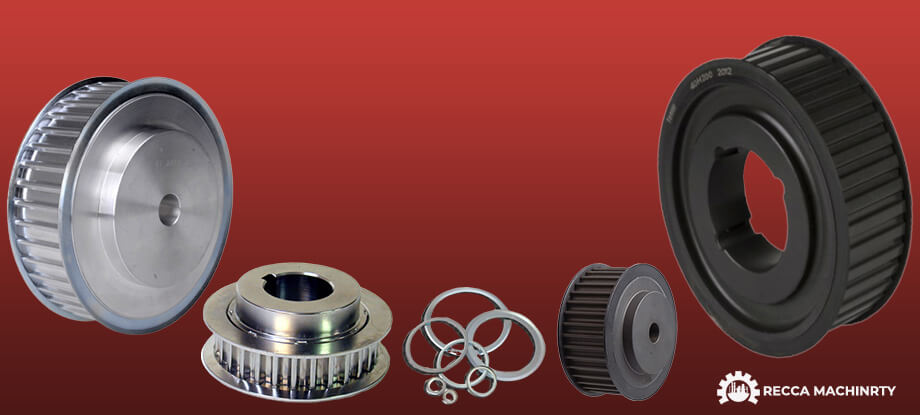
A sprocket is a mechanical component used in transmission systems, typically in conjunction with a chain to transmit mechanical power. The sprocket engages with the chain through its gear-like teeth, transferring rotational motion from the driving shaft to the driven shaft, thereby achieving power transmission and synchronized movement. The design and manufacturing quality of sprockets are crucial for the efficiency and longevity of the entire transmission system.
Sprockets are widely used across various industries. Here are some key application areas:
Types of Sprockets
Sprockets can be classified into various types based on their structure and application:
Recca Machinery is a professional sprocket manufacturer and supplier in China. Since 2006, we have been producing sprockets, consistently meeting the rising demands of our customers. The standard sprockets are supplied with a small pre-bore so they can be machined according to customers’ specifications. Additionally, taper bores are available. All Recca Sprockets can be made from special materials and subjected to heat and surface treatments according to customer requirements. Below are the different types of sprockets we can supply。
Materials and Manufacturing Processes
Our sprockets are made from high-quality alloy steel or stainless steel, manufactured using precise CNC machining techniques. Throughout the production process, we adhere to strict quality control standards to ensure that each sprocket meets design specifications. Additionally, we perform heat treatment and surface treatments on the sprockets to enhance their wear resistance and corrosion resistance, making them suitable for various complex working environments.
Our Advantages
As a professional mechanical component manufacturing factory, we have years of production experience and advanced manufacturing equipment. We are committed to providing high-quality sprocket products to meet various industrial needs. Our technical team can offer customized sprocket solutions based on the specific requirements of our customers, ensuring optimal performance in practical applications. Whether it’s small batch or large-scale production, we can adapt flexibly and deliver quickly, ensuring our customers’ production schedules.
◆ AlCuMgPb 6061 6082 Aluminum Timing Pulley
◆ C45E 1045 S45C Carbon Steel Timing Pulley
◆ GG25 HT250 Cast Iron Timing Pulley
◆ SUS303 SUS304 AISI431 Stainless Steel Timing Pulley
◆ Other material as per customer demand: cooper, bronze and plastic
◆ Anodized surface -Aluminum Pulleys
◆ Hard anodized surface — Aluminum Pulleys
◆ Black Oxidized surface — Steel Pulleys
◆ Zinc plated surface — Steel Pulleys
◆ Phosphating surface — Steel Pulleys; Cast Iron Pulleys
◆ Nickel plated surface –Steel Pulleys; Cast Iron Pulleys
Machining tolerance can meet H6 precision or customized.
Advantage: OEM/ODM services provide
◆ Plastic bags/kraft paper+cartons for light weight; Wooden case for heavy weight
◆ According to the customers ‘ demand
Toothed pulleys are coded on the basis of:
– the number of teeth
– pitch, expressed by one or more letters
– width, expressed in hundredths of an inch
– flange ( if any ) expressed by the letter F.
Exemple:
Pulley 10 XL 037 has:
– 10 teeth
– pitch identified by letters XL
– a belt width of 37 mm
Pulley Drawings Symbols
N = Number of pitch lengths or teeth on a pulley
P = Pitch is the distance between the axes of two adjacent teeth irrespective of whether these teeth are on the pulley or
the belt provided that measurement is taken on the circumferenceor pitch line
t = Belt thickness
Dp = The diameter of the pulley pitch is obtained from formula Dp = (P · N)/P
De = External diameter of pulley De=Dp – NF
Df = Flange diameter
d = Bore diameter
Dm = Hub diameter
F = Tooth width
L = Total length incl. Hub
This treatment is carried out on steel pulleys mostly for appearance. The resulting black iron oxide coating will not chip, peel, flake or rub off. A chemical degreasing pretreatment (pickling) is made before black oxiding and causes the deoxidation of the
pulleys. After black finishing, pulleys are oiled in order to protect surface from atmospheric oxidation. This treatment therefore will merely produce a black finish coating but it is not a corrosion-resistant treatment. To achieve a level of corrosion resistance, oil is applied on the pulleys.
This treatment is made on cast iron pulleys in order to obtain a good antioxidizing protection,
without modifying dimensionally the profiles and forms of the treated parts.The phosphating process, that produces on the surfaces of pieces a thin microcrystalline deposit with a basis of manganese and iron phosphates, is completed by an impregnation in protective oils that improves the resistance to the oxidizing agents of the microcrystalline coat itself. In addition to this, the phosphating gives, to the treated parts, a pleasant aeshetic appearance, due to the blackgray colour produced on their surface.